#Rations
Explore tagged Tumblr posts
Text

German soldiers make time to get something to eat - date and location unknown. Whilst the exact date and location is unknown, it is thought that the picture was taken during the early stages of the war
#world war two#ww2#worldwar2photos#1940s#ww2 history#wwii#history#world war 2#ww2history#wwii era#field kitchen#rations#western front
75 notes
·
View notes
Text

No Dog Biscuits Today, London 1939.
Photography by Vivian Mayer
#1930s#london#pre war#aesthetic#vintage#old school cool#style#beauty#doggos of tumblr#dog biscuits#childhood#adolescence#rations
51 notes
·
View notes
Text

Customers waiting in line to buy coffee, October 28, 1942. They were sold one pound each. Similar lines formed at other stores where coffee was being sold on a rationed basis.
Photo: Tom Sande for the AP
#vintage New York#1940s#Tom Sande#rations#war rations#coffee rationing#World War II#home front#1940s New York#Oct. 28#28 Oct.#line#queue
55 notes
·
View notes
Text

Otto's weakness is food.
#ottoway#ww1 fiction#my art#wwi#original comic#original characters#german#british#rations#educational#historical fiction#Otto Odinkirk#Edwin Vipond
23 notes
·
View notes
Text

A Roman lead bread stamp and impression which reads:-
CL.AVG.VIC.
'(made by) Victor, of the century of Claudius Augustanus'
Stamps like this were used on bread. The Romans did not have a catering corps for their army. Rations were issued 'in the raw' to the soldiers, and they had to prepare and cook their food themselves.
Grosvenor Museum, Chester
#romans#roman empire#roman soldiers#Roman food#ancient cultures#ancient living#archaeology#stamp#bread#roman britain#roman city#food#rations#Chester
49 notes
·
View notes
Text

Dean Cornwell, WW2 propaganda poster, 1943
The phrase "Are you playing square?" refers to Americans who purchased black market gasoline when it was being rationed among the civilian populace. A soldier looks to the audience to appeal to their sense of patriotism.
#pulp art#poster art#propaganda poster#WW2#square#40s#1940s#patriotic#patriotic art#rations#soldier art#WW2 art#dean cornwell
11 notes
·
View notes
Text
rations in urinetown

okay, so the idea of the ugc rationing food won’t get out of my head. like ww2 grocery shopping style.
so may i propose: scummy rich people overprice basic necessities (again)
URINE GOOD COMPANY
OFFICIAL RATION NOTICE
for immediate distribution
in accordance with the ongoing resource preservation mandates and to ensure equitable distribution during these trying times, the following rations are hereby allocated per individual per week. for detailed pricing in your district, please consult a friendly local officer of the law.
weekly rations (subject to change)
one small loaf of bread (note: may stale or mixed with fillers)
powdered milk, three servings
rice or oats, seven-hundred fifty grams
vegetables, two cans
dehydrated soup packets, three
as our company is both generous and blessed with a very lenient head of staff, when available, certain exclusive items will be available when stock permits (for an extra fee):
canned or dried fruit
salt
beef jerky
root vegetables
jam
canned mushrooms
pickled vegetables
dried or canned fish
canned meat
sugar
we thank you for your continued cooperation and resilience during these unprecedented times. remember, compliance ensures community stability and fairness for all.
URINE GOOD COMPANY
preserving life, preserving order.
#urinetown#theater#musical#musicals#musical theater#musical theatre#broadway#ugc#ration#rations#draft#headcanon#headcanons
17 notes
·
View notes
Text
Sunday Steve - Day Eleven
Things that would be new or unfamiliar to Steve in the 21st century, either due to the time period he grew up in, or his social-economic status and other such factors.
Day Eleven: Toilet Paper
People used many things as toilet paper before commercial toilet paper was available. As indoor plumbing became more common toilet paper became more necessary because pipes were not designed for almanac pages or newspapers.
In the late 1800s toilet paper was still a luxury but it was being developed. "In 1890, toilet paper started to look a lot more like stuff we’re used to seeing today. It came on a roll in perforated sheets. It was a tough sell though because no one wanted to admit to buying it. In Germany, a company called ‘ Hakle’ overcame the problem with the slogan “ask for a roll of Hakle if you don’t want to say toilet paper.” (Link)
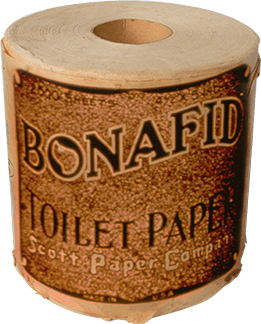
Late 1800s toilet paper. 2500 sheets.
Charmin began marketing its toilet paper around its softness in 1928, as well as selling economy-sized packs of four rolls in 1932 (Link).
There were two types of toilet paper. Soft and hard. "The hard paper was more affordable and was very shiny on one side of it" (Link). Hard paper often had printed text on it (most of the examples I've found are British).
Every source I've found says that toilet paper began to be advertised as "splinter free" in the 1935. Most casual articles don't dig into what this actually means, but I found some ads for the infamous splinter free toilet paper.
Splinters resulted from the manufacturing process, and as you can see in the below images the splinters were usually very small. I haven't been able to find out how genuinely inconvenient this splinters were.
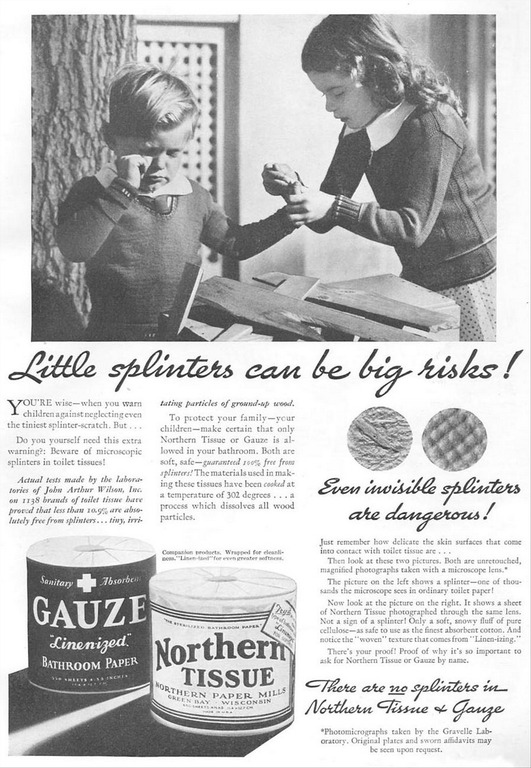

1930s toilet paper ad (Link) (Link)
You can see the various marketing methods for soft toilet paper, treating it like a medical issue and appealing to women.
You can also see 3 rolls being sold for 20-25 cents. I think that is very expensive for toilet paper in the 30s. I've found a source showing 2 rolls of Clifton toilet paper being sold for 9 cents in 1932. (Link) And this link shows 4 rolls of crepe toilet paper being sold for 19 cents in 1930 (Link is behind a pay wall but I managed to download the price list). I'm guessing the rolls in the splinter-free ads are soft toilet paper, and the cheaper examples I found are hard toilet paper.
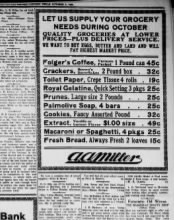
1930 grocery price list. Toilet paper is the third item, listing four crepe rolls for 19 cents.
In 1940 one roll is being sold for 15 cents (Link), but it's not clear if this is soft or hard toilet paper. I'm guessing soft since it's almost the price of four rolls in 1930.
My guess is Steve paid around 9 cents for 2 (19 cents for 4) rolls of hard toilet paper. I doubt he bought soft toilet paper since it cost about 20-25 cents for 2-3 rolls. But I can't know the prices for sure.
One thing for sure is modern toilet paper is softer than the paper Steve would have bought. Britain didn't even start manufacturing 2-ply toilet paper until 1942. Over the years soft toilet paper become the norm (although institutions like schools often have thinner, harder paper).
Given this information, Steve would probably be used to buying harder, cheaper toilet paper for about 9 cents for 2 rolls/19 cents for 4 rolls. Soft 'expensive' toilet paper would be surprising as the norm, and I think he'd find our massive packs of toilet paper shocking. Although as we'll see, soldiers were provided Waldorf paper, which seems to be a more softer, expensive brand.
Army Toilet Paper
Soldiers were provided toilet paper with K-rations and later with C-rations. A soldier would get one accessory packet a day with either ration and it came with twelve sheets of Waldorf toilet paper.
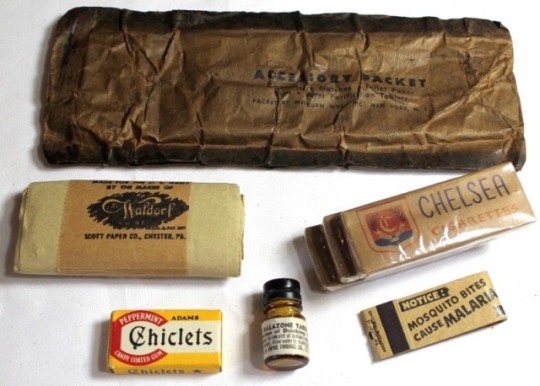
(Link) Accessory packet with Waldorf toilet paper.
You may have seen the factoid that British soldiers were rationed 3 sheets of toilet paper per day compared to American soldiers having 22 sheets. I believe this is a misinterpretation of this book discussing the resources available to American soldiers on base in Britain (pg. 288). But after further research I think the actual number of sheets British soldiers got a day on the front was 4 sheets. (Link) American soldiers got 12 sheets included in their K-ration. (Link)
If a soldier ran out of toilet paper they most likely had to make do. I've seen stories of pages from books being used, or even paper bills. (Link)
Bonus
First paper towels sold 1931 (Link).

1936 paper towel ad
Facial tissue paper originated from gas mask filters in World War One. Kleenex were marketed as a cold cream and makeup remover in the 20s and began being marketed for colds in the 30s. (Link)
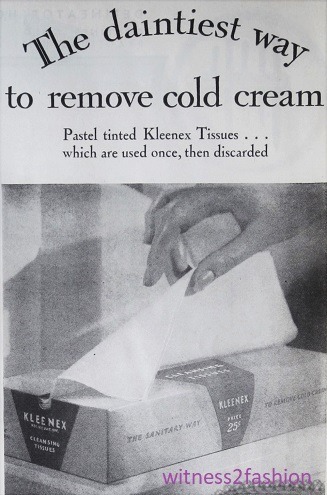
1930 ad for Kleenex for 25 cents.
Personally, I don't think Steve would have spent money on either of these things, but they did exist.
#sunday steve#steve rogers#toilet paper#crepe paper#history#american history#20th century#20th century history#steve rogers meta#meta#kleenex#paper towel#1900s#splinter free toilet paper#1930s#world war two#rations#army rations#early 20th century
20 notes
·
View notes
Text
I heard some people were complaining about the food. What do you want me to do about it? Do you want a plate of sushi? A steak? I DON'T HAVE ANY OF THESE THINGS WE ARE STUCK ON MARS YOU CAN STARVE IF YOU WANT TO NOT MY PROBLEM
2 notes
·
View notes
Note
What kind of food would merchants eat on a looong voyage?
Above all, cracker bread, whether that be the biskit, hardtack, rusk, whatever you want to call it. It's a twice-baked bread meant to be hard and dry so it wouldn't spoil for long periods of time. You could crumble it and cook it with meat fat for a hot meal. Salted pork and fish also kept for a while, you had to soak it to remove extra salt of course.
Of course, on a long voyage, there are regular stops to take on provisions (particularly fresh water), so there would be resupply with fresher foods. After a long stop between ports, any merchant would be eager for fresh food, whatever would be sold at the local markets.
Thanks for the question, Anon.
SomethingLikeALawyer, Hand of the King
16 notes
·
View notes
Text

Turns out war is good for something!
🔴🟡🔵🟢🟠🟤🟣🔴🟡🔵🟢🟠🟤🟣
#history#m&ms#forrest mars sr.#candy#military#american history#world war 2#historical figures#veterans#spanish civil war#food history#ww2#1910s#american military#1940s#military history#dessert#united states#delicious#rations#world war 2 history#chocolate#nickys facts
2 notes
·
View notes
Text

[Oatmeal] was mainly used to make porridge or 'burgoo' and eaten for breakfast with some form of sweetening, either sugar or molasses. Nelson got into a terrible tizzy about this sweetening in the Mediterranean when Victory's captain, Hardy, wrote him a formal letter in September 1804 stating that there had been no molasses in the ship since the previous June, and requesting that since there had not been an additional issue of oatmeal to make up for this, the men should be paid for the missing molasses as 'savings of provisions'. Nelson sent a copy of this letter to the Admiralty with his own covering letter [...] Could there not be a supply of cocoa or tea sent in lieu of molasses, as had been the case when he was in the West Indies, or at least sugar, he asked.
— Horatio Nelson pressed about feeding the Navy in Feeding Nelson's Navy: The True Story of Food at Sea in the Georgian Era, by Janet Macdonald.
#age of sail#royal navy#horatio nelson#nelson's navy#sailors#food#rations#naval history#maritime history#feeding nelson's navy#janet macdonald#nelson identified as man who would put sugar on his cereal
32 notes
·
View notes
Video
1941 Board Of Trade ad by totallymystified
#Board Of Trade#steel helmet#saucepan#rations#1941#1940s#forties#wartime#WW2#Second World War#World War Two#retro#vintage#nostalgia#ad#advert#advertising#advertisement#flickr
2 notes
·
View notes
Text
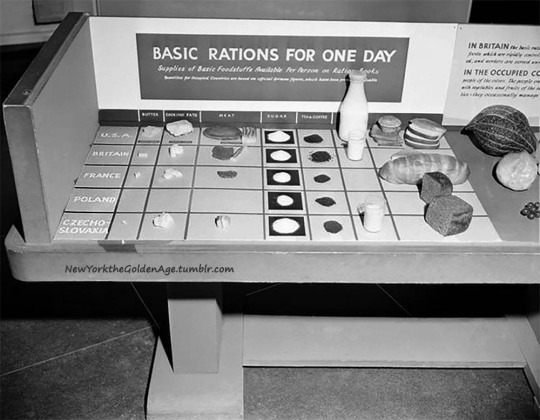
Americans at home had it easy during World War II. This display of foodstuffs, rationed and unrationed, in the United States as compared with several European countries, was an exhibit at the Museum of Science and Industry at Rockefeller Plaza, March 8, 1943. It shows basic rations for one day in the U.S., Britain, France, Poland, and Czechoslovakia. Sugar, tea, and coffee were the only rationed U.S. products at that time (meat and other food items had been rationed earlier) on this chart. In all other countries, every item displayed was rationed.
Charles Kenneth Lucas for the AP via Flashbak
#vintage New York#1940s#World War II#Charles Kenneth Lucas#home front#rations#rationed food#rations World War II#food#food rations#World War II at home
91 notes
·
View notes


